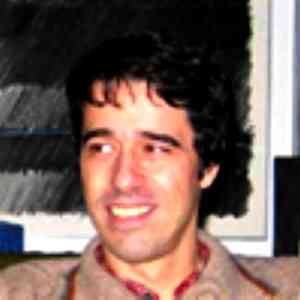
M y music will not break with the past or confront it … It only tries to communicate something very personal, something which may even not be communicable. I try to create something that may eventually have a glimpse of beauty.”
— João Pedro Paiva de Oliveira.
T here is a small left-shift, to a position where sound becomes an expression of equivocal encounters with technology’s pervasive presence ... The ‘emblem book’ is a quirky kind of hypertext that reached its peak in Europe in the mid-17th Century. Each emblem is composed of three elements: a motto, a visual symbol, and some epigrammatic prose ... The assemblage of poetic/acoustic, visual, and literary spaces invites personal reflection on the analogies to be made between its separate components. As a form, it invites readings from several directions and offers the opportunity for each reader to reach their own individual conclusions. The various metaphors, symbols, and digressions allow room for internal flight within the space of interpretation. There is freedom to travel back and forth.”Interactive Gestures, an evening of electroacoustic music and multimedia works, with guest artist João Pedro Paiva de Oliveira, will take place tonight, Friday, April 25 at 8:00 pm at La Esquina, at 1000 West 25th Street, Kansas City, Missouri. The event is co-sponsored by the American Institute of Architects (AIA) and by the UMKC Conservatory.
— Katharine Norman, Sounding Art, p. 29.
Portuguese composer João Pedro Paiva de Oliveira, visiting professor at the UMKC Conservatory, will be a featured artist. Oliveira has written in a variety of idioms, including chamber opera, requiem, orchestral, string quartet and other chamber and solo instrumental ensembles, and electroacoustic music. He currently serves as Senior Professor at Universidade de Aveiro where he teaches composition, music theory and analysis.
Interactive Gestures will include the following works by Oliveira:
- ‘A Escaba Estreita’ (winner of Musica Nova, Czech Republic, 2005), Rebecca Ashe, alto flute;
- ‘Time Spell’ for clarinet and tape, Cheryl Melfi, clarinet;
- ‘Aphar’ for eight channel playback (winner of the Concours International de Musique et d’ Art Sonore Electroacoustique de Bourges, France, 2007); and
- ‘Bloomy Girls’ for fixed media and video.
- ‘MHCHAOS’, Chris Biggs, computer, Rebecca Ashe, flute;
- ‘Tone Goblin’ for fixed media and video, Noah Keesecker;
- ‘Infested Readings’, Nihan Yesil;
- ‘Tower of Babel’ for eight channel digital playback, Jacob Gotlib; and
- ‘Third Option’, Jon Robertson, narrator, Joey Crane, guitar.

It’s paradigmatic in electro-acoustic music that very little is explicitly stated and that much is left to chance. But the drama is every bit as rich as more traditional forms. The music situates you in a pleasant altered state of awareness, peering as it were into your own subconscious, watching your mind form thoughts and associations.
Socially, this is not a solitary thing. Instead, it can be a shared experience that is every bit as much a stimulus to conversation and convivial speculation as any other chamber music event can be. The audience arranges itself in the midst of 8 loudspeakers, surrounded by 8 channels of exquisitely-mixed stimulations. Private confabulations become shared conversations, on topics that would never have arisen in any other way. That’s very much the spirit of the event at La Esquina this evening. Promoted on ClassicalLounge.com, it promises to be an exciting gathering. See you there!

- Urban Culture Project: Interactive Gestures. KCEMA and AIA UCP, La Esquina, Kansas City, 25-APR-2008, 20:00.
- NOVARS Research Centre for Electroacoustic Composition, Performance and Sound-Art, Univ Manchester
- EARS (Electro-Acoustic Resource Site) at de Montfort University
- Algorithmic.net
- Bourges International Electroacoustic Music Academy
- Ressources.Electro
- International Confederation of Electroacoustic Music (CIME-ICEM)
- Jacob Gotlib page on MySpace
- Gotlib Electroacoustic Music for Flute
- Urban Culture Project (UCP)
- Subliminal.org
- Eric Leonardson experimental instruments
- Braun H-J, ed. Music and Technology in the Twentieth Century. Johns Hopkins, 2002.
- d'Escrivan J, Collins N, eds. The Cambridge Companion to Electronic Music. Cambridge Univ, 2008.
- Lansky P. Etudes & Parodies. (Bridge, 2007.)
- Lansky P. Things She Carried. (Bridge, 2006.)
- Lansky P. Music Box. (Bridge, 2006.)
- Lansky P. Ride. (Bridge, 2005.)
- Lansky P. Conversation Pieces. (Bridge, 2004.)
- Licata T, ed. Electroacoustic Music: Analytical Perspectives. Greenwood, 2002.
- Manning P. Electronic and Computer Music. Oxford Univ, 2004.
- Norman K. Sounding Art. Ashgate, 2004.
- Ohm: Early Gurus of Electronic Music. (Ellipsis, 2005.)
- Simoni M, ed. Analytical Methods of Electroacoustic Music. Routledge, 2005.
- Composers In The Schools program (UMKC Conservatory)

No comments:
Post a Comment